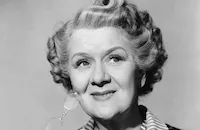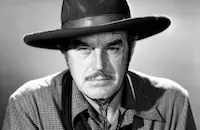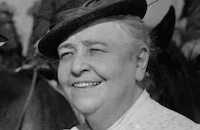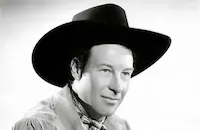Wonder Bar
Brief Synopsis
Cast & Crew
Lloyd Bacon
Al Jolson
Kay Francis
Dolores Del Rio
Ricardo Cortez
Dick Powell
Film Details
Technical Specs

Synopsis
Popular Parisian nightclub the Wonder Bar is run by Al Wonder, who is also the star performer. He and his band leader Tommy are both in love with dancer Ynez, but she only has eyes for her partner, gigolo Harry. Harry, however, does not return her love and is carrying on a flirtation with Liane Renaud, the wife of a banker. Liane has given him an expensive necklace to pay for dancing lessons, which Harry intends to sell in order to finance a trip to the United States. At the Wonder Bar one evening, Liane's husband joins her and hints that the insurance company will investigate the lost necklace. Liane asks Harry for the necklace and insists that she will leave the country with him. Harry sells the necklace to Al, who talks Liane out of leaving her husband, and returns the necklace to her. He hopes that with Harry gone, Ynez will turn to him. Meanwhile, two American couples flirt with the gigolos and gigolettes of the club. Captain Von Ferring, having lost all his money, announces that he will commit suicide that evening. When Harry tells Ynez that he is leaving without her, Ynez stabs him during their dance number. Harry dies, but Al tells Ynez that she has only wounded him. He puts the body in Von Ferring's car and, when Von Ferring drives it over a cliff, the police think that both men were killed in the crash. During Al's last number, Tommy convinces Ynez to come back to him. Al will not stand in their way and goes home alone at the end of the night.

Director

Lloyd Bacon
Cast

Al Jolson

Kay Francis

Dolores Del Rio

Ricardo Cortez

Dick Powell

Guy Kibbee

Ruth Donnelly

Hugh Herbert

Louise Fazenda
Hal Leroy
Fifi D'orsay

Merna Kennedy

Henry O'neill

Robert Barrat

Henry Kolker
Kathryn Sergava
Gordon De Main

Harry Woods
Marie Moreau

George Irving
Emil Chautard

Pauline Garon
Mahlon Norvell
Alphonse Martel
Mia Ichioka
William Granger
Rolfe Sedan
Gino Corrado

Eddie Kane

Edward Keane

Jane Darwell
Demetrius Alexis
John Marlowe
William Anderson
Grace Hayle

Gordon Elliott
Paul Power
Dick Good
Michael Dalmatoff
Renee Whitney
Amo Ingraham
Rosalie Roy
Lottie Williams

Clay Clement
William Stack
Spencer Charters
Gene Perry
Louis Ardizoni
Robert Graves
Alfred P. James
Crew
George Amy
Earl Baldwin
Busby Berkeley
Louis De Angelis
Al Dubin
Frank Flanagan
Leo F. Forbstein
Michael Joyce
Bert Longworth
Robert Lord
Jack Okey
Orry-kelly
Willy Pogany
Sol Polito
Harry Warren

Photo Collections
Film Details
Technical Specs

Articles
Wonder Bar
Jolson isn't so much its star as its emcee, at times uneasily cast as the owner and host of the Parisian nightclub that gives the film its title. The space is the usual arrangement of art deco swirls, the focal point being the bandstand from which Jolie holds forth, dispensing his unique brand of steamrolling bonhomie. He always was a knock 'em dead belter, but the manner that worked for him onstage and later on radio didn't always sit comfortably on camera in the more intimate cutaways to close-ups from full-scale production numbers. Although he made history by literally giving movies a voice in The Jazz Singer in 1927, film was not his natural element (as it was for his wife, Ruby Keeler, whose career rose as Jolson's languished, putting the inevitable showbiz strain on their marriage).
It isn't long before he's put to the test here in a scene likely intended as no more than a piece of throwaway naughtiness at the time, but since has been cited as a milestone in gay cinema, chosen to open the Rob Epstein-Jeffrey Friedman documentary, The Celluloid Closet. There's no closet when a tuxedoed dandy in pencil mustache interrupts a dancing couple, asking if he can cut in. When he gets a yes, it isn't the woman he dances off with, but the man, prompting Jolson to mincingly quip, "Boys will be boys. Woooo!" What's striking about the moment is its offhandedness, its lightness, its freedom from the painful self-consciousness attending so many subsequent gay portrayals in Hollywood films.
Not that Wonder Bar is a model of diversity and easy acceptance. Busby Berkeley (whose wife, Merna Kennedy, plays a nightclub flirt), fresh from the triumphs of 42nd Street, Gold Diggers of 1933 and Footlight Parade (all 1933), was full of verve, confidence and technical ingenuity. His first production number here, the "Valse Amoureuse" danced to the Al Dubin-Harry Warren "Don't Say Goodnight," is as spectacular as any of his better-known numbers. Using octagonal mirrors (and managing never to have his traveling camera reflected in any of them!), he deployed 100 dancers against huge moving columns, multiplying his kaleidoscopic formations, making them seem a dreamy army, with its giddy swirls photographed in serenely morphing geometric flowerings from above. It's his second number, "Going to Heaven on a Mule," the big closer he wrote for Jolson, that's the problem.
Even if we allow that it was in part a parody of Marc Connelly's The Green Pastures, a pseudo-folk rendering of an African-American heaven that won a Pulitzer in 1930, but today is virtually unwatchable, Going to Heaven on a Mule is cringe-makingly appalling in its racial stereotyping. (Its insensitivity is signaled earlier in a brief but offensive exchange between Jolson and an Asian checkroom worker.) Not even a glancing reference to Eugene O'Neill's The Emperor Jones can disguise it from the fact that it's a blackface routine, with Jolson as a dying field hand in overalls and worn work shirt, departing his decrepit shack for an art deco afterlife.
Most of the singing and dancing there takes place at the intersection of The Milky Way and Lenox Avenue as if heaven's newest resident would have heard of either. He's accompanied in a safely sexless way (we hope!) by his beloved mule. Pansy angels fit him out with wings as Bill Bojangles Robinson appears as a tap-dancing angel in black tights, white spats, a shiny top hat and wings of his own. Whew! To its credit, though, Warner Bros. left the scene in shades of the Birth of a Nation (1915) controversy in miniature! -- and it got past the censors, who also let stand a character literally getting away with murder.
Meanwhile, in the sleek cocoon of the spiffy club, the envelope of permissibility is also pushed, most notably by Raymond Cortez's floor-show dance star and offstage gigolo, in a sado-masochistic gaucho whip dance with his slinky, sexy partner, Dolores Del Rio. It still crackles, bringing down the house lined with rich old lascivious swells like Guy Kibbee and Hugh Herbert and wall-to-wall gigolos in tailored evening wear. Boyish crooner Dick Powell, in his pre-tough guy phase, singing his way up the ladder alongside Berkeley at Warner's, actually does more singing and in a more modern way than Jolson. Both compete for Del Rio, but they share the songs.
Young or old, the women literally shine in marcelled hair. Louise Fazenda and Ruth Donnelly, as battleaxe wives, look like beaded bags. Del Rio, shimmering in her sequined gown, a standout among rank after rank of Jean Harlow wannabe platinum blondes, reminds us how much the costuming genuflected to the play of light in black and white. Del Rio is gorgeous, but Kay Francis is wasted in sulkiness as the petulant wife of a bored banker whose gift of her jewelry to Cortez's gigolo sets the multi-stranded plot in motion.
As Jolson shuttles between outmoded blackface minstrelry and fast-talking urban cockiness (sentimentality, too!), the familiar character actors add reassuring notes of solidity and continuity to the far from unified proceedings. Not that the many plot strands don't fall neatly into place. They were designed to. Nor would it do to take a too-condescending view of Wonder Bar. The signs in the club are in French and the occasional Gallic phrase or sentence remains untranslated, trusting to a certain level of audience savvy. It does, after all, date from a time of an unspoken assumption that one was obliged to meet life with a certain sense of style, and this enlivens its studio-made, Depression-fighting escapism still.
Producer: Robert Lord
Director: Lloyd Bacon
Screenplay: Earl Baldwin, Geza Herczeg (play), Karl Farkas (play), Robert Katscher (play)
Cinematography: Sol Polito
Film Editing: George Amy
Art Direction: Jack Okey, Willy Pogany
Music: Alexis Dubin, Harry Warren
Cast: Al Jolson (Al Wonder), Kay Francis (Liane Renaud), Dolores del Rio (Inez), Ricardo Cortez (Harry), Dick Powell (Tommy), Guy Kibbee (Henry Simpson).
BW-84m.
by Jay Carr

Wonder Bar
Quotes
Trivia
One scene gave the censors some consternation: A man asks a couple if he can cut into their dance, and while the woman says, "sure," and rushes towards him, he dances away with her partner. Al Jolson, hearing this says with a twinkle, "Boys will be boys." Warner Bros. refused to excise the scene (and it is in the Turner Classic Movies print). At the time, the Production Code was not rigorously enforced. Surprisingly, however, the movie was approved in 1936 despite this homosexual scene and the fact that someone gets away with murder, both violations of the code.
Notes
The American version of the play, which opened in New York on 17 Jay 1931, was adapted from the German by Irving Caesar and Aben Kandel. Al Jolson's contract called for him to receive 10% of the film's gross receipts. This was one of the top moneymaking films of the year. According to Film Daily, Irving Kahal and Sammy Fain were originally set to write the music. Ruby Keeler, Adolphe Menjou, Bette Davis, Ann Dvorak and Barbara Stanwyck were considered for parts. According to modern sources, Warner Bros. submitted an incomplete version of the film to the MPPDA, assuring the officials that the missing footage "contained nothing to worry about." The completed print, however, contained a scene where an effeminate man cut in on a dancing couple and danced away with the man. Despite pressure from Joseph I. Breen, Public Relations Director of the MPPDA, Warner Bros. refused to eliminate the footage. According to modern sources, Frank Borzage was originally scheduled to direct this film.

Miscellaneous Notes
Released in United States 1934
Released in United States March 1977
Released in United States 1934
Released in United States March 1977 (Shown at FILMEX: Los Angeles International Film Exposition (The Mighty Musical Movie Marathon) March 9-27, 1977.)














